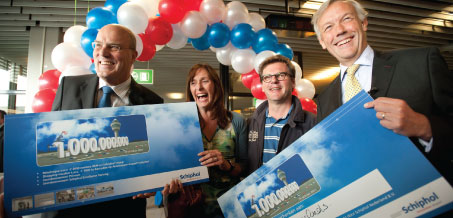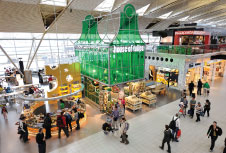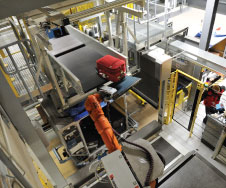
Amsterdam Airport Schiphol welcomed its one-billionth passenger – Ms Inge Serné – in October. She was greeted by Peter Hartman, President and CEO of KLM, and Jos Nijhuis, President and CEO of Amsterdam Airport Schiphol.
The one-billionth passenger is an important milestone for the airport, particularly in the context of the airport’s growth. Schiphol was founded in 1916 and the 500-millionth passenger was welcomed in 2000 – only 11 years ago. The Netherlands itself has a relatively small domestic market, so Schiphol’s growth, to a significant extent, results from its hub function for Air France KLM. “The one-billionth passenger is, in that sense, a celebration of Schiphol as the window of the Netherlands to the outside world,” commented Rutten.
The refurbished Departure Lounge 3 was opened in September. For its design, Schiphol contracted the architectural firms of Benthem Crouwel NACO and Merkx+Girod, whose main task was to create an innovative retail and leisure area characterised by calm, light and logic. “The light, layered design of the façade gives the departure lounge its own, unmistakable identity. The subtle dot pattern was inspired by maps and embraces the shops like a soft skin,” said Rutten. “The refurbished lounge presents an exciting synergy of Dutch and international brands.”
Dutch designer Tjep designed a prominent area of the lounge. At its centre is a restaurant (Bread), cheese counter (Say Cheese) and a flower shop (House of Tulips) – all three concepts are strongly rooted in Dutch culture.
The flower shop became a glass canal house that elevates and descends over a small market display. When lifted up, the content of the house is spread out to form a small market. “The glass house represents the production source – Holland is the country of green houses – and the canal house represents the possible destination for the flowers. This combination of references makes it possible to avoid obvious clichés,” explained Rutten. “For Bread we developed a giant bread display! A feeling of authenticity has been underlined by the exclusive use of massive ash wood throughout the entire concept – inspired by construction elements used on the inside of antique Dutch windmills.”
Sustainability played a vital role in the renovation of Departure Lounge 3, with sustainable building options used wherever possible. There is no additional demand for energy, while the number of facilities for the customer has grown. LED lighting has been used, as far as possible, in all of the shops. All information boards and screens have been designed to use less energy.
Energy Strategy 2020
Corporate Responsibility forms an integral part of Schiphol Group’s strategy; numerous initiatives are undertaken, placing a focus on safety, the environment and the surrounding region. The Energy Strategy 2020 programme sets out Schiphol’s targets in terms of responsible energy use and the reduction of fossil fuel consumption. This will be achieved through five different initiatives: creating an efficient energy management system, stimulating third parties at the airport to do the same, producing and storing sustainable energy onsite, applying IT to learn more about energy usage patterns, and increasing the level of awareness among Schiphol staff.
“Amsterdam Airport Schiphol intends to be CO2 neutral by 2012 with respect to the activities of the Aviation, Consumers and Real Estate business areas at the Schiphol location,” commented Rutten.
The airport has been recognised at the ‘Optimisation’ level of ACI EUROPE’s Airport Carbon Accreditation. It has developed a step-by-step plan to achieve a maximum reduction in CO2 emissions. For example, it plans to cut energy and fuel consumption, use required energy and fuel more efficiently, use sustainable energy and fuel, and compensate for its consumption.
Business trips made with Air France KLM are compensated via the KLM CO2 compensation service; trips made with other airlines are compensated through the Climate Neutral Group. At the end of 2010, Schiphol Group issued a tender for the purchase of 20 electric vehicles to be deployed in airport operations.
Expanding baggage capacity

The refurbished Departure Lounge 3 was opened in September. Dutch designer Tjep designed a prominent area of the lounge. At its centre is a restaurant (Bread), cheese counter (Say Cheese) and a flower shop (House of Tulips). The flower shop became a glass canal house that elevates and descends over a small market display. When lifted up, the content of the house is spread out to form a small market.
Schiphol’s South Baggage Hall went into operation in March and has since won numerous awards. It is a significant element of the major investment programme known as 70MB (70 million bags), which is being implemented to expand baggage capacity. The airport is cooperating with airlines and handling agents on the 70MB programme, in which it plans to invest nearly €800 million in the period between 2002 and 2013. “The programme will allow us to handle 70 million baggage items per year and will help increase the capacity and flexibility of our baggage system, improve the quality of baggage handling and working conditions in the baggage halls – through, for example, mechanisation – and reduce the costs per baggage item for airlines,” explained Rutten. “The innovative, state-of-the-art technology used to reach these goals is unique in the world. Several awards for innovation have therefore been awarded to this project.”
The new 15,000sqm South Baggage Hall, located to the south of Departure Hall 1, is considered the showpiece of the 70MB investment programme. It is an ultra-modern space with six loading robots, two transfer unloading quays and a large-scale buffer with 4,200 storage positions. The hall is able to facilitate the baggage handling for several airlines for both check-in and transfer baggage, and was designed to facilitate efficient baggage handling in peak times, with the buffer used to store baggage with no immediate priority. Once the peak has subsided, baggage is sent from the buffer to the robots, which then start loading the containers. Schiphol is carrying out this project in collaboration with KLM, Vanderlande Industries and IBM. Vanderlande Industries, IBM and Grenzebach Automation designed, built and tested the system, which features space efficient applications with robotised loading of baggage.

Schiphol’s South Baggage Hall went into operation in March and has since won numerous awards. It is a significant element of the major investment programme known as 70MB (70 million bags), which is being implemented to expand baggage capacity.
Social media
Schiphol is embracing social media. It has more than 22,000 ‘likes’ on Facebook and over 3,000 followers on Twitter. Meanwhile, the Schiphol App for iPhone and Android has, so far, been downloaded more than 340,000 times. In addition, around 20% of visits to the airport’s website are via mobile.
“We started listening to customers and other people on social media who were talking about Schiphol. On the basis of the gathered information, we formulated our social media goals. At the beginning of 2011 we slowly started using social media actively. Little by little we are expanding our activities,” said Rutten. “Schiphol Group has its social media policy decentralised: people within the organisation use social media proactively and reactively to interact with our customers.”
The fifth busiest airport in Europe, Schiphol is experiencing continued growth, with throughput expected to reach 49 million this year. Welcoming its one-billionth passenger in October was a significant milestone for the airport, which has established a network of 303 destinations in more than 100 countries. Schiphol has grown into an airport that is vital to the Dutch economy and an important driving force for job creation in the region. Through its environmental initiatives and carbon reduction efforts, Schiphol is also demonstrating its commitment to growing sustainably.







